THE PAST AND THE FUTURE OF NZ FISHING NEWS
By Grant Dixon
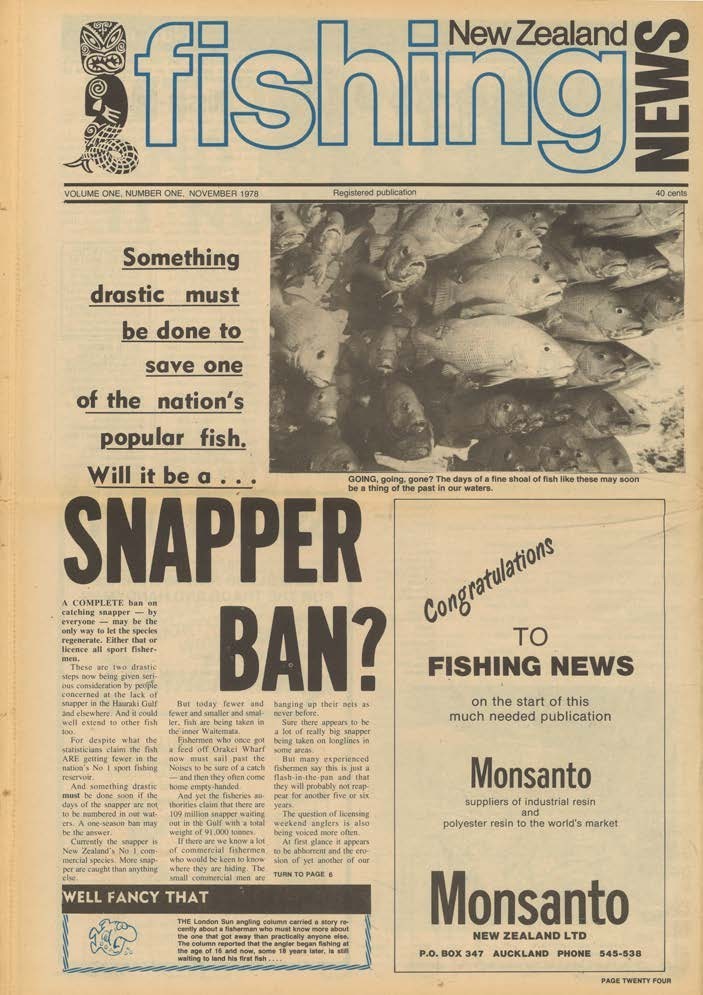
The very first edition of NZ Fishing News was published in November 1978. It was long on sensationalism and short on accuracy.
Having been published for nearly half a century, NZ Fishing News has long been the ‘anglers’ bible’, undergoing several ownership changes and formats as various publishers have sought to keep up with modern trends and do the best for their audiences.
This issue represents what some are describing as a ‘new dawn’ as the magazine morphs from its monthly offering to a quarterly hi-gloss publication, working hand-in-hand with its other ‘arm’, the popular website www. fishing.net.nz (The Fishing Website).
NZ Fishing News (FN) has an interesting history. Around the time when I joined the crew as Editor, long-serving contributor and contractor Sam Mossman produced an article titled ‘Behind the Covers of Fishing News’, encapsulating the publication’s first decadeand-a-half.
Issue #1 hit the streets in November 1978, initially as a monthly 24-page, black and white tabloid published by Rugby Press and edited by John Wilson. Wilson was a tabloid journalist by training, with little fishing background, and during his editorship the publication tended to be long on sensationalism and short on accuracy. The very first edition had an in-yourface, screaming, part-72pt capitalised headline: ‘Something drastic must be done to save one of the nation’s popular fish. Will it be a SNAPPER BAN?’ The story was light on detail and accompanied by a large image showing a school of tropical fish, an early example of ‘never letting the truth get in the way of a good story’!
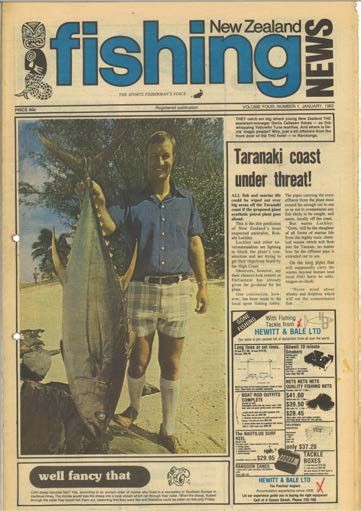
January 1982 – the first colour cover.
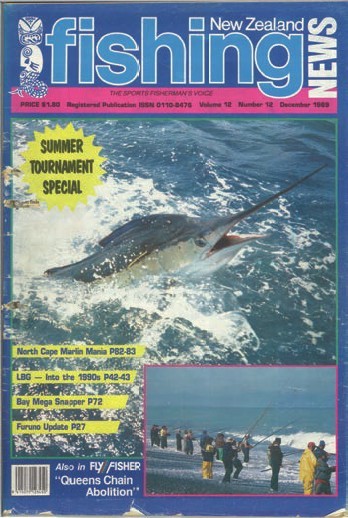
December 1989 – the first gloss cover.
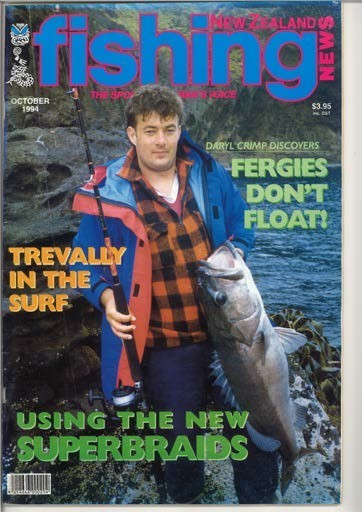
October 1994 – a ‘puka from the rocks made a worthy cover shot.
Political correctness did not feature in Wilson’s vocabulary as he published a page three Mermaid of the Month in the style of the NZ Truth, a weekly tabloid popular at the time. Several other columnists ran the PC gauntlet, their contributions proving popular, but unlikely to make the cut today. The late Murray Ormsby contributed the popular Wiremu column where the main character lived on the edge of the law with regard to fishing regulations. Rotorua-based contributor Kevin Coutts wrote a series of articles that often included comments from another fictional character – Morrie from Ngapuna – who also knew every scam or rort going.
Free alcohol dispensed by lycra-clad, lithe young ladies was another FN ‘hit’. At one show event, we had the Black Heart girls helping to promote the newly introduced RDT rum and cokes from our stand. The show was held over five days, and with the help of the Black Heart girls dispensing their product we sold a record 1,000-plus subs that year.
Wilson was the instigator of the Bill Hohepa character, which eventually became so big that a real person, Aucklander Wayne Wills, had to be found to assume the persona. These days, Wills is Bill Hohepa.
Older readers will remember the Māori motif adopted by Wilson and run for many years as part of the FN masthead. It turns out the publisher had ‘borrowed’ the taniwha design from the Tainui people whose business endeavours had it registered as their trademark. They were very good about it once they heard how the magazine had acquired it, even going so far as to create an alternative for us.
Publication was a little irregular during Wilson’s time, with some winter issues skipped when fishing activities, and the advertising dollar, were at a low point. In January 1982, the first colour cover was produced, and then in October 1983 a new editor took the helm, Australian David Stokes. Stokes was also the proprietor of a charter operation called Northland Fishing Tours, and the paper’s content and accuracy benefitted from his fishing background and the beginnings of the sportfishing boom that took hold in subsequent years.
However, it also suffered from over-exposure of Stokes’ own charter business. Following the collapse of his operation, FN was acquired by Mike Airey in December of 1984, as a partial debt settlement.
A retired Air NZ pilot, Mike was looking for a business to get his teeth into. FN began to grow both in size and circulation from this point, going from 24 pages in June 1985 to 36 pages six months later. The first internal colour pages appeared at the end of 1986.
In August of 1987, Airey formed a partnership with Bill and Jo Kirk, turning over the dayto-day running of the title to them, while he concentrated on starting a new fishing paper in Australia. In September 1988, following a dispute, the Kirks were dismissed from FN, and Mike Airey took up the editorship again, with the aid of Assistant Editor (subsequently appointed Editor) Steve Sneddon, and business manager (and son) Mark Airey. The Kirks went on to produce NZ Fisherman in opposition to their former title. The magazine sometime later was bought by Independent Newspapers Limited (INL) and amalgamated with FN.
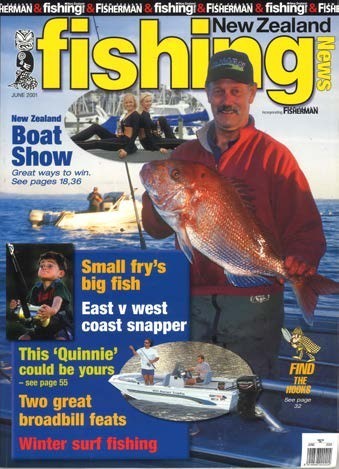
January 1997 – showing some artistic flair!
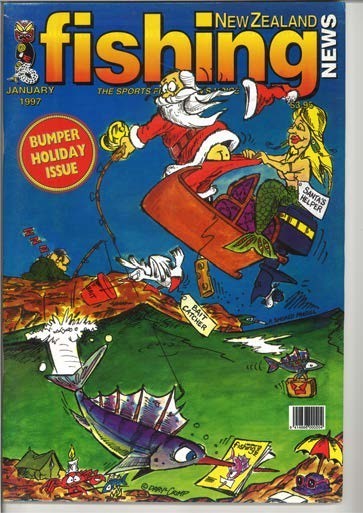
June 2001 – evidence of the amalgamation with NZ Fisherman.
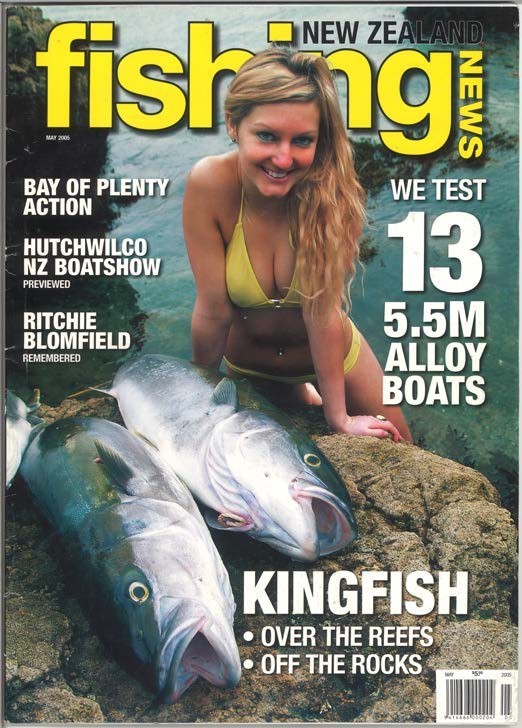
May 2005 – longstanding readers will remember Captain Bucko’s cover shots.
The inclusion of Flyfisher and Leisure sections in the November 1988 issue lifted the paper to 64 pages with 16 pages of colour. This division did not prove to be a great success, and the flyfishing section was subsequently absorbed back into the body of the paper, while the leisure section was discontinued.
In August 1989 FN was produced for the first time as a stitch-and-trim magazine. Circulation and size both continued to grow, and the December 1989 issue hit 96 pages, with 34 pages of colour including the first gloss cover. Boosted by a boom in recreational fishing, FN reached 146 pages by December 1990, a size it has generally maintained, given seasonal fluctuations, up to the present day. In more recent, pre-COVID 19 times, the popular December and January issues were consistently over 200 pages, the biggest one ever running at a massive 220 pages.
Sam joined the magazine on a more formal basis in July 1991, having been a contributor since July 1986. Mike Airey sold the title to INL in 1992, staying on as Manager for a year, and then serving a further year as head of the newly-formed magazines group. Mark Airey was subsequently appointed General Manager, and Steve Sneddon served as Editor until his resignation in August 1993. I was Steve’s replacement, moving on from my role as Editor of the Morrinsville-based INL paper Piako Post and before that the privately owned Te Awamutu Courier. My community newspaper background put me in good stead – after all, the FN audience was a ‘community of anglers’ where names were news.
Around this time, competition was starting to hot up with a further three dedicated fishing magazines launched in the following years, along with four other hunting-fishing or boatingfishing magazines. Despite this, FN continued as the clear leader in the fishing magazine market, boasting the largest circulation of any marine magazine in Australasia at one point.
Continuing innovations saw the development of an in-house desktop publishing system, and the production of an A4 glossy quarterly magazine produced in conjunction with the New Zealand Fish and Game Council, appropriately titled Fish and Game NZ. It was aimed mostly at the freshwater angler, and specifically at the coffee table and tourist market. Edited by Bob South, the magazine was well received, with the pre-duckshooting and trout season issues particularly well supported.
Over the years we went from accepting just about anything for publication to the more specific commissioning of articles. Current Editorial Director Nick Jones has this as one of his strengths, reflected in the magazine’s content in more recent times.
The magazine, and its associated website www.fishing. net.nz, have been at the forefront of the recreational fishing political scene. The option4 group, which morphed into the NZ Sport Fishing Council’s public advocacy arm LegaSea, was (and still is) heavily supported, with FN recognised as a truly independent voice to spread the message.

April 2008 – a gold badge to honour 30 years in print.
VERSATILITY THE HALLMARK OF SAM MOSSMAN’S CONTRIBUTIONS

Sam Mossman is the magazine’s longeststanding contributor, staff member, and editorial contractor, his first articles appearing in the magazine 38 years ago.
“Soon after starting, then owner/editor Mike Airey also tasked me with doing regular boat tests for the magazine which were soon given the regular banner Trailer Boat Trials, as strong boating content was deemed necessary to break into the boating advertising market,” Sam recalls.
“FN already had pretty much all the fishing advertising going, but it was not enough to expand the magazine in the way he wanted.”
Sam was a regular contributor for five years until joining the magazine on a formal basis in July 1991, initially working 10 days a month, but within a year this was expanded to 15 days.
As well as boat tests, monthly articles on many aspects of fish and fishing, and tackle tests, Sam worked on various custom publications and started columns like Tips and Tricks, Setting Up for Sportfishing, Top Tucker (FN’s first cooking column), and Something Fishy, to name a few, as well as collating FN’s wide-ranging Area Reports and the long-running Take a Kid Fishing contest. His fish/travel articles have covered some of the world’s more remote angling destinations under the Offshore Adventures tagline.
Over his time with the magazine, Sam has seen a huge change in the publishing technology and the processes to get the printed word onto paper.
“When I started, production consisted of cutting typed text into columns, waxing the back and using a roller and scalpel to attach it to a backing page. Photo reproduction was black and white and of appalling quality. Newsprint bleed was a big problem. Over the years desktop publishing, hugely improved camera (and photo) quality, the moves to better and better paper, and formats from loose leaf, to stapled, to stitch and trim, have made FN into a magazine to be proud of.”
Sam says there was a time when FN felt like a huge family, with contributors throughout New Zealand and the Pacific.
“The most junior member had been there 12 years. Everyone knew their jobs and did them well, and socialised outside of work, too. It felt like there was extended family right throughout the country, too – our area reporters, fishing clubs, tackle manufacturers and retailers, boat manufacturers, fish scientists and many more. FN seemed more than just a magazine, it was kind of the junction box of recreational fishing, where all things came together.”
While Sam has covered many topics, there have been a couple of articles that he has been particularly proud of.
“Two articles that took the most work and were subsequently a great satisfaction to see in print were Marlin and the Moon, and one on the commercial fleet targeting broadbill.
“For the first I acquired marlin catch records from 1929 on 11,000 fish, and figured out the lunar day they were caught on. It was a whole lot of number crunching, but it was satisfying to get a result based on statistics rather than gut feelings.”
Sam says the broadbill targeting story was important because the commercial sector had agreed not to do this. The catch stats and other data proved they were breaking the agreement.
“A lot of research was involved but you don’t often get to feel like an investigative reporter.
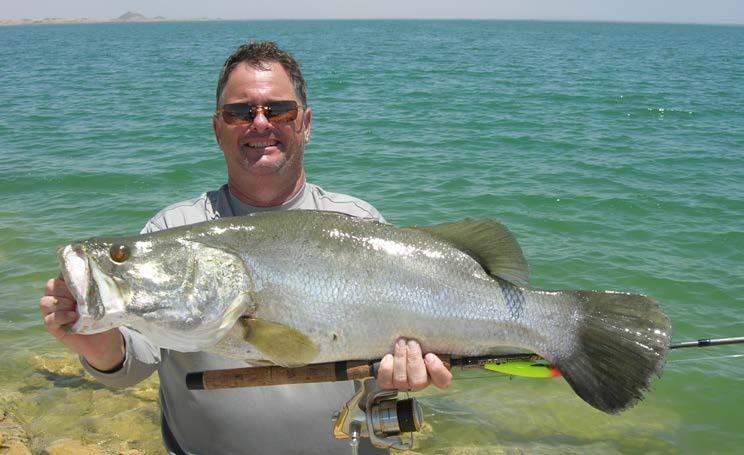
Sam Mossman has had a 38-year-long association with NZ Fishing News which continues today. Over the years he has introduced readers to far-flung countries and fisheries, such as Egypt and its Nile perch.
“Also personally satisfying was a piece I wrote back in 2016 detailing the sorry history of New Zealand’s fisheries management and suggesting some ways forward. Along with FN, I sent it to several people involved in fighting for public fishing rights. It has been satisfying to see some of these concepts advanced by these groups since.
“It was always good to feel that FN had my back whenever a ‘hot potato’ upset the authorities.”
Apart from that, Sam has always particularly enjoyed Craig Worthington’s pieces. “They are well written, well thought out, well illustrated, and always interesting.”
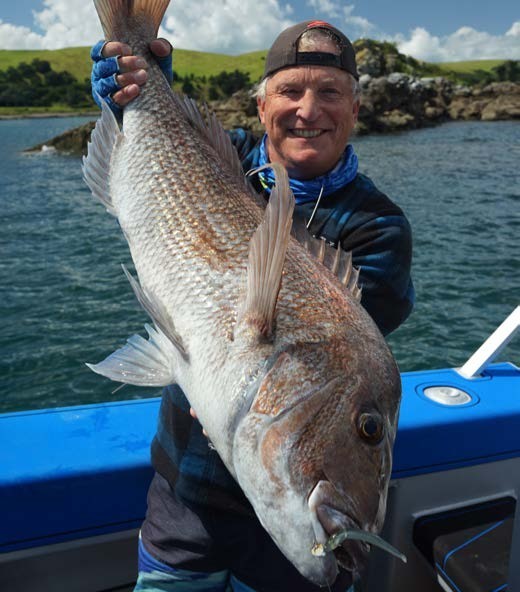
Mark Kitteridge is excited to continue sharing his knowledge with the NZ Fishing News audience.
SHARING KNOWLEDGE A FEATURE OF MARK KITTERIDGE’S WORK
An association with FN has played a big part in Mark Kitteridge’s life in many ways. Initially, it allowed him to develop his writing and fishing skills, and share what he had learned.
“Thinking back, some of my early ideas and theories make me cringe now,” Mark says.
“I started writing for the mag around 1981 after being mistaken in an FN photo for the article’s writer Craig Worthington (we both had a lot of hair in those days!); it showed me with a big landbased kingfish around 27kg and I was disappointed not to get the credit, so I wrote a story about how it happened. Editor John Wilson responded to my submission by saying he loved the feature and could I write a regular column in future? Of course I said yes!”
That carried on for a while until Mark became an official Area Reporter, something he undertook for many years. It was followed by a few years as Deputy Editor for NZ Fisherman, followed by his move to FN.
After many years with the publication, Mark moved to Ocean
Angler as Sales Manager, followed by Senior Salesman at North Shore Hunting & Fishing, but his association with FN remains strong.
“In retrospect, I must say I was disappointed that the personnel following me did such a great job, I didn’t seem to be missed at all!
“Throughout all this time I have been fortunate to have been published virtually every month for around 43 years – and I hope to continue for many more under the new model.
“I’ll always be grateful for the many opportunities provided by FN over such a long time. It enabled me to go to places I’d normally only have been able to dream of, especially overseas, and to go with top fishers and skippers who taught me so much.
“I guess that’s why the instructional features I write so often give me the biggest buzz these days; I still love sharing what I’ve learnt, but now that I know so much more, I feel like I can make a big difference to people’s fishing success and enjoyment, especially when it comes to fishing with lures.”

May 2011 – the magazine has always worked closely with fishing personalities.
“ THE MAGAZINE HAS ALWAYS BEEN KEEN TO DEVELOP WRITERS AND LEADERS... ”
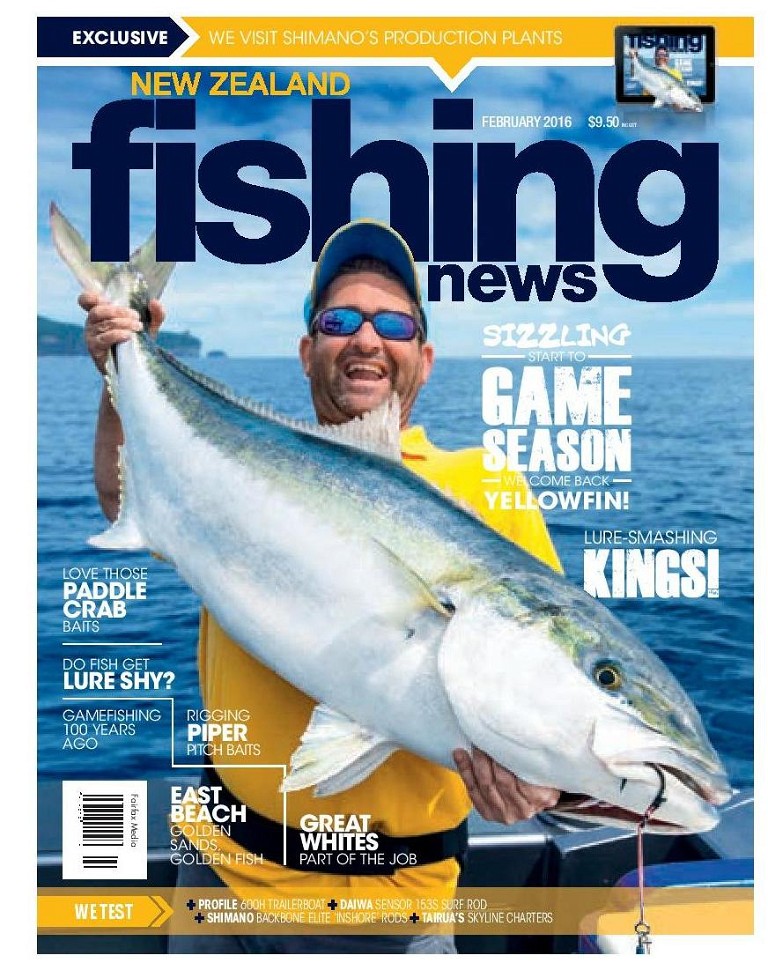
February 2016 – a busy cover hinting at high pagination.
Supporting and encouraging junior anglers (and readers!) has been high on the agenda. Readership surveys indicated the Mercury Take a Kid Fishing pages were among the most read. The Hiwi the Kiwi pages instigated by the NZSFC spread fishing, water safety, and environmental best practice to the younger set. The Young Yarns column, in which Hayden Speed was the key contributor, was another channel through which the magazine reached out to younger readers.
The concept of measuring rather than weighing fish for tournaments was a cause strongly supported by NZ Fishing
Media, the company started in conjunction with Grant Blair when we bought the title from Fairfax in 2016. With backing from several key stakeholders, the publishers set up a nationwide, measurebased annual contest, the brainchild of company Managing Director Grant Blair.
The magazine has always been keen to develop writers and leaders, starting with Miah Dixon who came on board as Deputy Editor, progressing to Editor before leaving for bigger and brighter things. Ethan Neville, who had been editing the Rheem OffSite publication, stepped up to the plate for a short while, followed by incumbent Nick. Nick has a well-rounded ‘game’. Apart from having a passion for fishing, he has an analytical approach to a wide range of subjects and the skills to convey his thoughts succinctly to a broad audience.
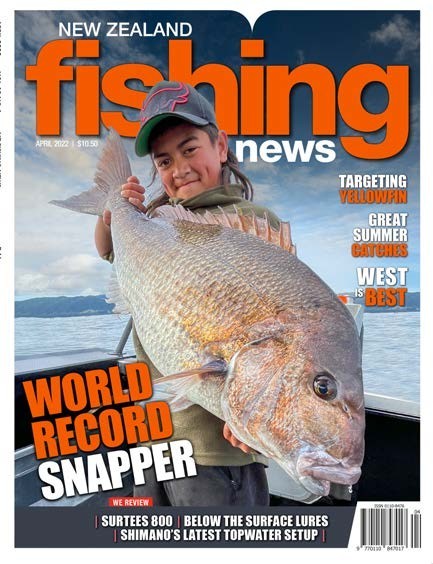
April 2022 – encouraging junior anglers has been high on the agenda.
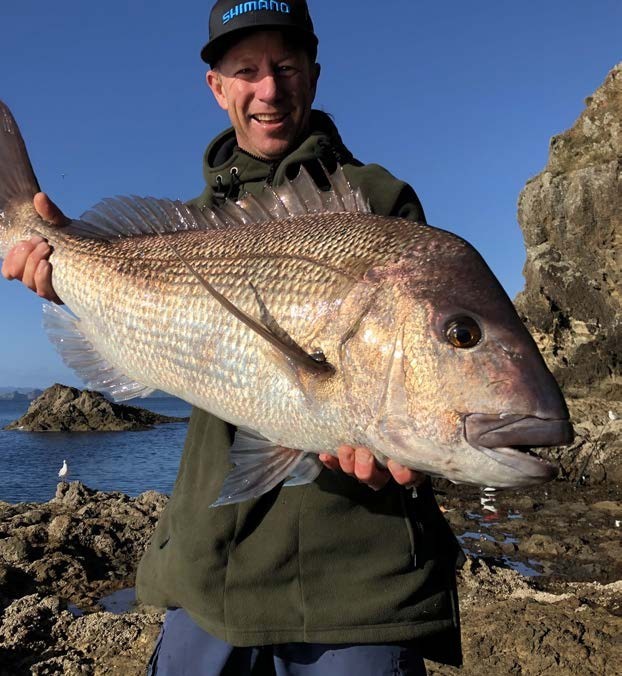
Matt Watson says reading early copies of NZ Fishing News opened his eyes to a fishing world beyond the murky waters of the Manukau.
MAGAZINE A CATALYST TO MATT WATSON’S STELLAR CAREER
Over the years FN has provided a print media platform on which a number of our rec fishing personalities have launched their careers, or at least enhanced them.
In the early days it was Geoff Thomas, Graeme Sinclair and Bill Hohepa; in more recent times Nicky Sinden, Scott Parry and Mig Rumney, Adam Clancey, and probably the most successful of them all – Matt Watson.
Matt reflects on what FN has meant to him personally, starting from a very young age:
“In the ‘80s, the newsstand in the dairy was what Facebook and Instagram are today for fishing enthusiasts. While deciding how to get the best value lollies for my 50 cents of pocket money, my eye was caught by a black and white picture of a giant snapper hanging by its tail on a trawler in the Bay of Plenty. The snapper was on the cover of a newspaper, and it was almost as big as a man. I had to know more, so I sacrificed a bag of delicious sweets and purchased my first copy of FN.
“From that point on I keenly awaited the next issue. I didn’t always buy it, mostly I flicked through the pages until the lady who owned the dairy barked, ‘If you aren’t going to buy that you have to leave!’ To me, FN was a chance to learn about all the incredible fish, fishing methods, and fishing spots, because as a kid my fishing was limited to the wharf, and small dories in the muddy shallows of the Manukau Harbour, so everything and everyone in FN seemed so professional, and the gear was so flash!
“To put it in simple terms I was inspired by FN. I didn’t even know marlin existed in New Zealand until I read about them in the magazine, and after careful study of every article I rigged my own gear and became the first person to bring a marlin into my local boat ramp in Weymouth. Without FN, this would likely have never happened. That is just one example of many – the effect this magazine has had on my life is profound. Thank you to each and all of the contributors over the years.”
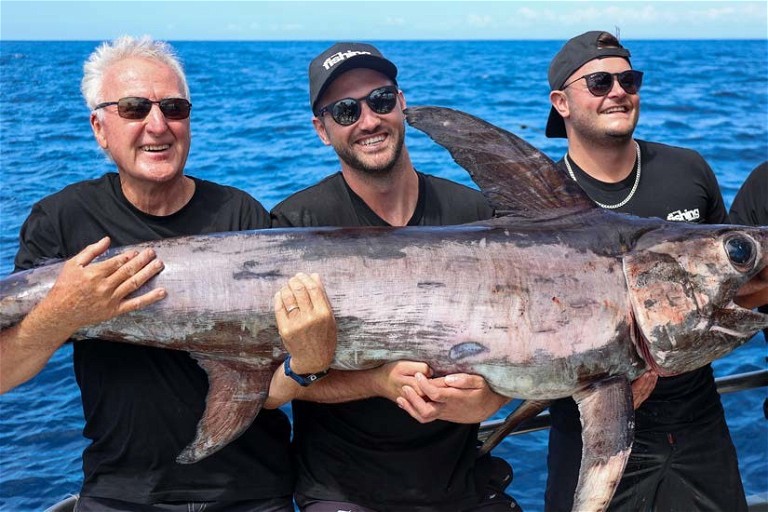
The new management team that will drive NZ Fishing Media into the future – Grant Blair (left), Nick Jones (middle), and Josh Williams (right).
I retired from the daily cut and thrust of publishing in December last year after 30 years at the keyboard, forever grateful to have had a strong team of colleagues and editorial contributors around me. There are too many to acknowledge all personally, but some who have since ‘crossed the bar’ and made their mark on the title include Bill Hall, Noel Baty, Peter Shutt, Paul Barnes, and Keith Draper.
As well as strong contributors, we have also been blessed with some great designers and production teams. Ricky Harris, our current designer, has been a stalwart, one of his strengths being able to decipher our page layout plans and turn them into works of art.
As FN turns the page on another chapter in its history, I have full confidence in Nick, Josh Williams (Commercial Director), and Grant Blair – they have the enthusiasm and drive to continue delivering high standards for both our print and digital (The Fishing Website) audiences, not to mention the many loyal FN clients.

February 2023 – who doesn’t love a jumping marlin?
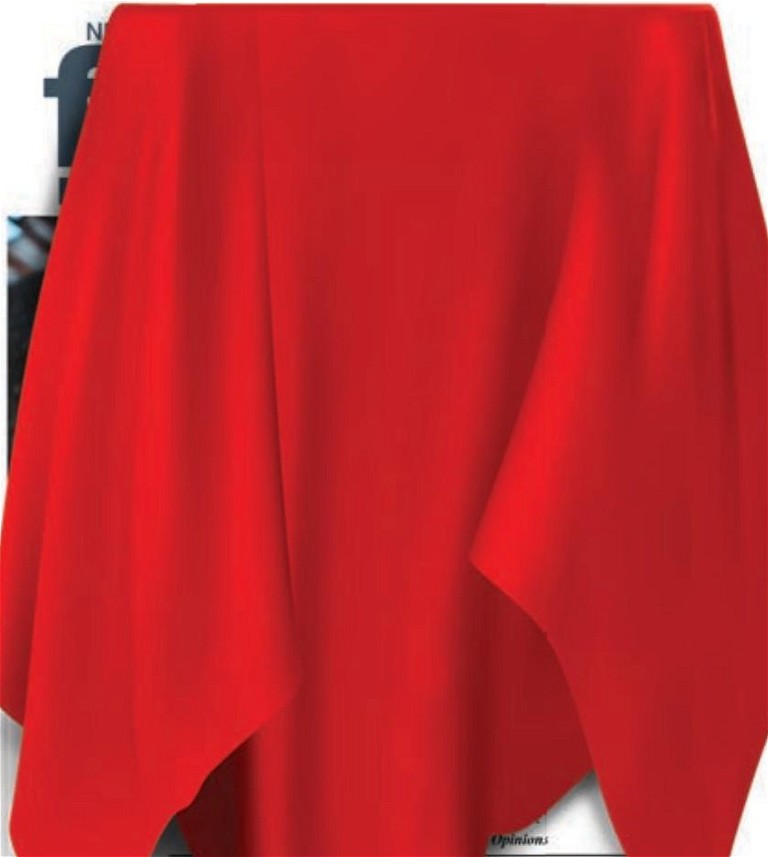
Spring 2024 – under construction!
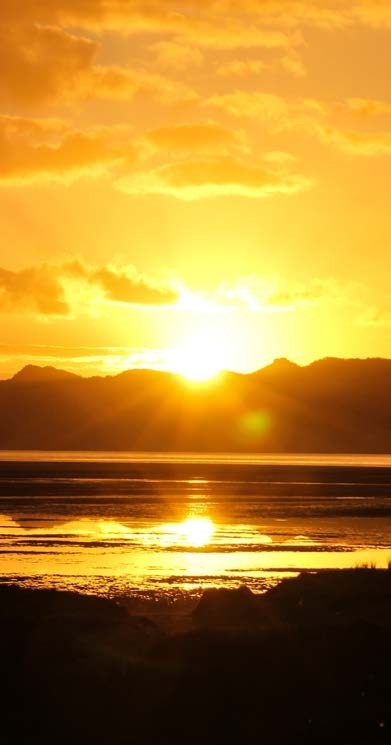
Photo: Guy Macindoe.
A NEW DAWN
The first coffee tablestyle quarterly edition of NZ Fishing News will hit the shelves in late August. Get ready for compelling features, in-depth research, and intel from some of the best anglers around the country – all aligned with the natural rhythms of the fishing season.
In the meantime, make sure to visit The Fishing Website —fishing.net.nz. It’s New Zealand’s most-visited fishing website and contains a wealth of NZ Fishing News articles, tips and tricks, regular reports, and intel to help you maximise your time on the water. You can also follow our adventures on social media (@nzfishingnews).
Finally, keep your eyes peeled for information on how to sign up for our premium digital subscriber platform, due to go live on The Fishing Website next month. For less than $1 a week, you’ll have exclusive access to the latest content at your fingertips.